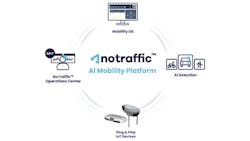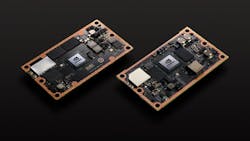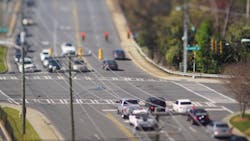From rural hamlets to congested urban centers, public officials typically manage traffic flow using techniques first adopted more than 100 years ago. Thanks to AI and IoT—including vision sensors—that situation is changing.
NoTraffic (Tel Aviv, Israel), a startup founded in 2017, is an example of a technology company with a smart traffic management platform designed around a different approach to this age-old problem.
It garnered $17.5 million in series A funding in 2021 and $50 million in series B funding in 2023.
NoTraffic’s technology platform combines camera and radar sensors with AI and both edge and cloud computing. A combination of hardware and software installed at each approach to an intersection (i.e., north, south, east, west) tracks road users continuously. The result is an intelligent network, or grid, that operates in real time and responds to changing conditions, such as the number and types of road users, to optimize traffic flow.
At least three localities have tested the platform and released information publicly. In addition, Tal Kreisler, co-founder and CEO of NoTraffic, says, “We already have a presence in dozens of cities across North America.”
This new approach to handling congestion is a type of Smart Cities initiative—an approach to managing daily urban operations based on data from connected and embedded devices, such as vision sensors.
Indeed, the company has a relationship with Rogers Communications (Toronto, CAN), which is promoting its 5G wireless platform as a data transmission backbone for IoT devices.
Traffic Congestion Status Quo
Kreisler says the company’s traffic management platform is a radical departure from existing solutions, which typically start with traffic counts taken at various intersections over time. “It is a statistical study that’s supposed to tell us how traffic is behaving on a normal day.”
Based on the study, government officials create a plan for “allocating the green light,” he adds. Coordination between intersections is typically handled as if the lights were a series of clocks. For example, if intersection A has a green light, intersection B will have a green light 30 seconds later. Each light operates independently and is not connected to other lights.
With this relatively static approach, “you have no ability to react to changing environments or road conditions,” Kreisler explains, leading to congestion and frustrated road users.
In addition to snarled traffic, other negative consequences of this approach include excessive carbon dioxide emissions and traffic accidents.
Related: Smart City Success Through Connected Sensors and Edge Analytics
NoTraffic Vision
In the case of NoTraffic, the sensing devices installed at each intersection fuse information from both the RGB camera and radar, which is then processed by computer vision algorithms to identify various types of road users, including pedestrians, trucks, buses, cars, bicycles, and emergency vehicles.
The data processing occurs on a NVIDIA (Santa Clara, CA, USA) Jetson AI TX 2 computing device, which is installed inside an enclosure that also includes the sensors.
After the images are processed and objects identified, a cloud-based AI-enabled microsimulation algorithm calculates optimal signal timing and synchronization among numerous signals. It calculates optimal signal times thousands of times per second.
In addition to input from traffic-light-level sensors, the algorithm considers other variables including historical data on the user demand at each leg of an intersection. It also applies rules—such as the prioritization of some user groups over others—determined by local government officials.
Custom Component Development
Kreisler says NoTraffic has developed both the RBG camera and radar components in-house. “Essentially, we have a unique problem that we need to solve,” he adds. In addition to identifying types of road users, the platform also must recognize “edge cases,” such as glare, fog, or occluded objects.
Explaining further, he says, “It took us a few years to move from a POC (proof-of-concept) level to full production.”
The second piece of the local IoT infrastructure is a hardware device, which is installed inside the electrical cabinet located at the base of the traffic light. It operates as a communications hub, connecting sensor devices to NoTraffic’s cloud-based computing infrastructure.
This device also feeds information about when to change a traffic light to an existing traffic-light controller, also located inside the cabinet.
Related: New York City Uses Mobile Cameras to Catch Vehicles in Bus Lanes
Local transportation officials access cloud-based management software to view real-time information on their traffic operations and to set traffic management policies. “It’s a management system that allows the agency to operate the traffic lights as a network, so they can get indications about maintenance issues; they can get indications about abnormal events,” Kreisler says.
The last component is the remote traffic operations center, which provides technical support to local officials and feeds system updates to the embedded components.
NoTraffic sells its service as a hardware-enabled software-as-a-service (SaaS).
Driving Toward an Autonomous Vehicle Future
NoTraffic’s executives also have equipped the platform with the capability to communicate with connected vehicles based on either dedicated short-range communications service (DSRC) or cellular vehicle-to-everything (C-V2X) standards. The standards govern the exchange of traffic information gathered from IoT devices in vehicles and local traffic infrastructure.
Even though this type of communications technology is in its infancy, he says, “Our agenda, our vision, is that we will start to deploy these systems."
The AI-enabled Machine Vision System’s Performance
NoTraffic has partnered with governmental and commercial operations to test its solution.
For example, NoTraffic worked with government officials in the Phoenix (AZ, USA) metropolitan area in 2020 to install its solution at one intersection in Chandler, Arizona for a pilot test. The project was funded out of the emergency technology program at Maricopa Association of Governments (Phoenix, AZ, USA). NoTraffic says the results of the test showed that a system-wide delay in the traffic corridor was reduced by 30.2 seconds per vehicle to 29.1 seconds per vehicle.
In another example, Redlands, California, conducted a two-month pilot program at two intersections representing 2% of the city’s signals. NoTraffic says it eliminated a total of 900 hours from residents’ commuting times and 11 tons from vehicle emissions.
In another example, NoTraffic, in partnership with Rogers Communications, in 2022 installed its mobility platform at five heavily used intersections on the campus of the University of British Columbia (Vancouver, CAN).
The pilot program was built on an existing research partnership between Rogers Communications and the university in which the communications provider installed a 5G wireless network throughout the campus.
Related: How Smart Cameras Are Used in Digital Twin Platforms
After a two-week trial, the partnership measured outcomes and found that the system reduced pedestrian delays by 93.42 hours and vehicle delays by 181.67 hours. They also calculated a 2.8-ton reduction in carbon dioxide emissions.
Based on those results, NoTraffic calculated what would have happened if the system was operating at all 727 intersections in the city during the test, concluding that it would have reduced pedestrian delays by 55,164 hours and vehicle delays by 139,921 hours.
Whether it’s pedestrians, bikes, or vehicles, the goal is to make sure they hit as many green lights as possible, balancing throughput on the main artery with access for side-street users. After all, Kreiser notes that waiting at a succession of traffic lights is “very frustrating and not efficient.”
About the Author
Linda Wilson
Editor in Chief
Linda Wilson joined the team at Vision Systems Design in 2022. She has more than 25 years of experience in B2B publishing and has written for numerous publications, including Modern Healthcare, InformationWeek, Computerworld, Health Data Management, and many others. Before joining VSD, she was the senior editor at Medical Laboratory Observer, a sister publication to VSD.



